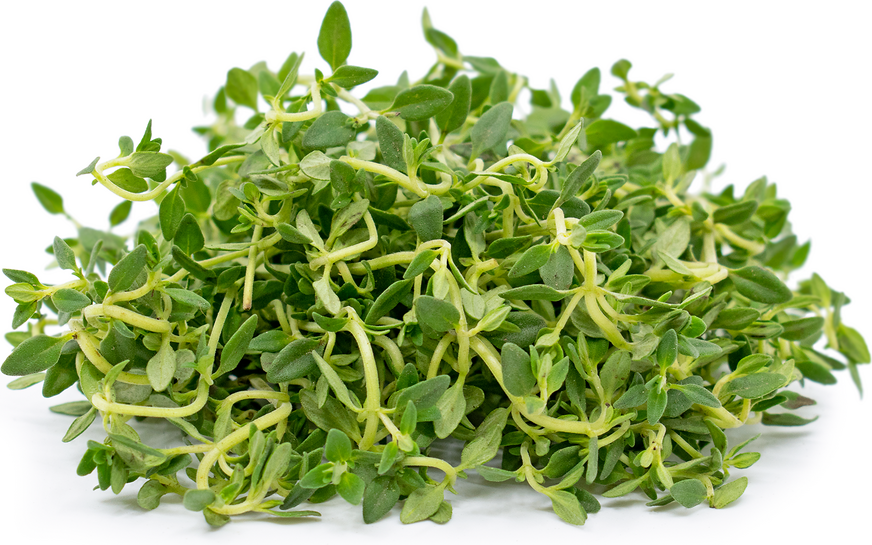


Lemon Thyme
Estimated Inventory, lb : 4.50
This item was last sold on : 07/11/25
Description/Taste
Lemon thyme is an aromatic shrubby herb with a rampant spreading habit, growing 15 to 30 centimeters tall and up to 45 centimeters wide, if not more, forming a ground cover. Its tiny leaves grow in clusters along thin, tender, light green, upward-branching stems that, when mature, become woody at the base and sprout whorls of small lilac flowers at the end. The dark green, narrowly-ovate leaves are extremely small, measuring only 1 millimeter in size, and they have a bright citrus scent that reaches its peak aroma just before the plant flowers. As the name implies, Lemon thyme offers a lemon-like flavor that cuts some of the bitterness typical of common thyme.
Seasons/Availability
Lemon thyme is available year-round.
Current Facts
Lemon thyme was long thought to be a hybrid, however, recent DNA testing has determined it to be its own species, botanically classified as Thymus citriodorus. It is one of hundreds of thyme varieties in the Lamiaceae, or mint family, only a few of which are suited for culinary use. Lemon thyme and common thyme are the two most often used in cooking, and while they closely resemble each other, Lemon thyme cultivars are distinguished by their lemony aroma and taste. Outside the kitchen, Lemon thyme is also known to be an effective mosquito repellent when crushed, thanks to its essential oils, which are also used for commercial products like deodorants, disinfectants, and more.
Nutritional Value
Lemon thyme is rich in iron, as well as vitamins C, D, and B-complex. The essential oil in Lemon thyme contains natural compounds that provide antioxidant and antiseptic properties, notably a compound called thymol, which also gives the herb its citrusy flavor. Lemon thyme has been used for centuries in herbal medicine, often prescribed as a respiratory aid to strengthen the lungs and expel phlegm, such as by drinking a decongesting and relaxing Lemon thyme tea. The compound, thymol, has also historically been used in food preservation methods, especially for meat, thanks to its pleasant flavor and natural antibacterial properties.
Applications
Lemon thyme is a popular culinary herb that can be used fresh or dried and can shine by itself or as part of a blend alongside other common herbs like rosemary, sage, and marjoram. Fresh Lemon thyme leaves can be added whole or chopped at any stage of cooking, however, the fibrous stems will not break down during cooking, so be sure to remove the leaves from the stems beforehand or pick out and discard the stems before serving. Lemon thyme can be used as a garnish or to add a bright, citrusy flavor to vinegar, herbed butter, sauces, teas, salads, soups or stocks, and even savory baked dishes like shortbread cookies or scones. It can be used in any recipe calling for lemon juice or lemon zest and pairs exceptionally well with chicken, fish, and roasted vegetables. Store fresh sprigs of Lemon thyme loosely wrapped in a damp paper towel and sealed inside a plastic bag in the refrigerator for up to two weeks. If the fresh leaves have been removed from the stem, they will keep in a sealed container in the refrigerator for up to three days. Dried Lemon thyme will keep for up to six months in an airtight container.
Ethnic/Cultural Info
Thyme has served a function in many fields throughout its long history, from the galley to the battleground and medicine to mythology. The Romans used thyme to symbolize bravery and strength by pinning it to their garments before battle or adding it to bathwater to impart vigor. In medieval Europe, legends abounded that wild thyme could attract mythical fairies, especially on midsummer's eve, as was supported by Shakespeare himself in A Midsummer Night's Dream. It was also used to treat skin lesions caused by the Black Death and was believed to help protect against infection thanks to its natural antiseptic properties.
Geography/History
Thyme is native to the Mediterranean, growing wild in Greece, Southern France, Italy, Spain, and parts of Northern Africa. It has been cultivated for thousands of years, and its history dates back to the Ancient Greeks and Romans, who helped spread the herb throughout Europe. It was commonly produced in England by the mid-16th century, and today it is grown in many areas worldwide with temperate climates and mild winters. Lemon thyme is a drought-tolerant plant that grows especially well in somewhat dry, sunny conditions and can easily be grown in home gardens or sunny windowsills. Lemon thyme is a popular culinary herb found at local farmer's markets, certain grocery stores, and specialty shops.
Featured Restaurants
Restaurants currently purchasing this product as an ingredient for their menu.
| Carruth Cellars Urban Winery | San Diego CA | 619-546-9300 |
| Inn at Rancho Santa Fe (Bar) | Rancho Santa Fe CA | 858-381-8289 |
| Pacific Terrace Hotel | San Diego CA | 858-581-3500 |
| Paradisaea Dodo Bird | La Jolla CA | 732-915-6669 |
| Solterra Winery + Kitchen | Encinitas CA | 858-245-6146 |
| Le Coq | La Jolla CA | 858-427-1500 |
| Jeune Et Jolie | Carlsbad CA | 858-231-0862 |
| Juniper & Ivy | San Diego CA | 858-481-3666 |
| Webbcreationfood LLC | San Diego CA | 619-829-9194 |
| Lafayette Hotel - Quixote | San Diego CA | 619-296-2101 |
| Crust Pizzeria Solana Beach | Solana Beach CA | 858-212-8751 |
| Pacific Yacht Agents | Los Angeles CA | 808-214-0970 |
| Seasoned Catering and Events | San Diego CA | 619-246-4909 |
| Cutwater Spirits | San Diego CA | 619-672-3848 |
| C 2 C | San Diego CA | 619-972-9345 |
| Beaumont's | San Diego CA | 858-459-0474 |
Recipe Ideas
Recipes that include Lemon Thyme. One




